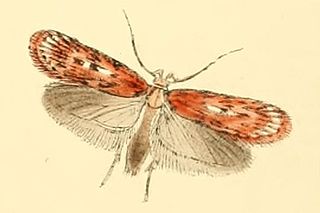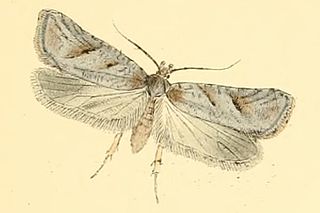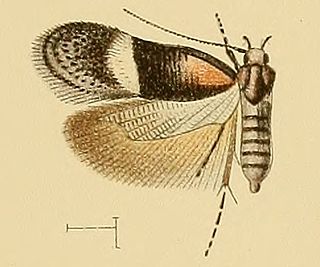
Eilema caniola, the hoary footman, is a moth of the family Erebidae. The species was first described by Jacob Hübner in 1808.

The gorse tip moth is a smallish moth species of the family Depressariidae.

Depressaria is a genus of moths in the superfamily Gelechioidea. It is the type genus of subfamily Depressariinae, which is often – particularly in older treatments – considered a distinct family Depressariidae or included in the Elachistidae, but actually seems to belong in the Oecophoridae.

Agonopterix umbellana is a moth of the family Depressariidae. It is native to western Europe, but was introduced to Hawaii in 1988 and New Zealand in 1990 to control Ulex europaeus.

Egira conspicillaris, the silver cloud, is a moth of the family Noctuidae. The species was first described by Carl Linnaeus in his 1758 10th edition of Systema Naturae. It is found from the Iberian Peninsula to Russia. In the north it ranges to the Baltic Region and in the south to North Africa. It is also present in the Near East, up to the Caspian Sea.

Depressaria chaerophylli is a moth of the family Depressariidae.

Depressaria daucella is a moth of the family Depressariidae. It is found in most of Europe, except most of the Balkan Peninsula. It is also found in North America.

Depressaria badiella is a moth of the family Depressariidae. It is found in most of Europe, Libya, the Caucasus and Mongolia.
Depressaria douglasella is a moth of the family Depressariidae. It is found in most of Europe.

Depressaria pulcherrimella is a moth of the family Depressariidae. It is found in most of Europe, except the Balkan Peninsula.

Depressaria ultimella is a moth of the family Depressariidae. It is found in most of Europe, except Spain, Norway, Finland, Lithuania, Switzerland, Italy and most of the Balkan Peninsula.
Depressaria radiosquamella is a moth of the family Depressariidae. It is found on Corsica.

Exaeretia allisella is a moth of the family Depressariidae. It is found in most of northern and central Europe, Siberia, the Russian Far East, Mongolia and northern and central China.

Elaphria venustula is a moth of the family Noctuidae. It is found in most of Europe, except the north. In the east, the range extends through the Palearctic to the Pacific Ocean.

Syncopacma genistae is a moth of the family Gelechiidae. It is found on the Canary Islands.
Depressaria togata is a moth in the family Depressariidae. It was described by Lord Walsingham in 1889. It is found in North America, where it has been recorded from Montana, from British Columbia to Arizona and in Oregon and Washington.

Syncopacma vinella, the Brighton sober, is a moth of the family Gelechiidae. It was described by Bankes in 1898. It is found in Europe, where it has been recorded from Denmark to Hungary, and from Great Britain to Slovakia.
Depressaria clausulata is a moth in the family Depressariidae. It was described by Edward Meyrick in 1911. It is found in South Africa.
Depressaria orthobathra is a moth in the family Depressariidae. It was described by Edward Meyrick in 1918. It is found in South Africa.
Depressaria rhodoscelis is a moth in the family Depressariidae. It was described by Edward Meyrick in 1920. It is found in South Africa.












